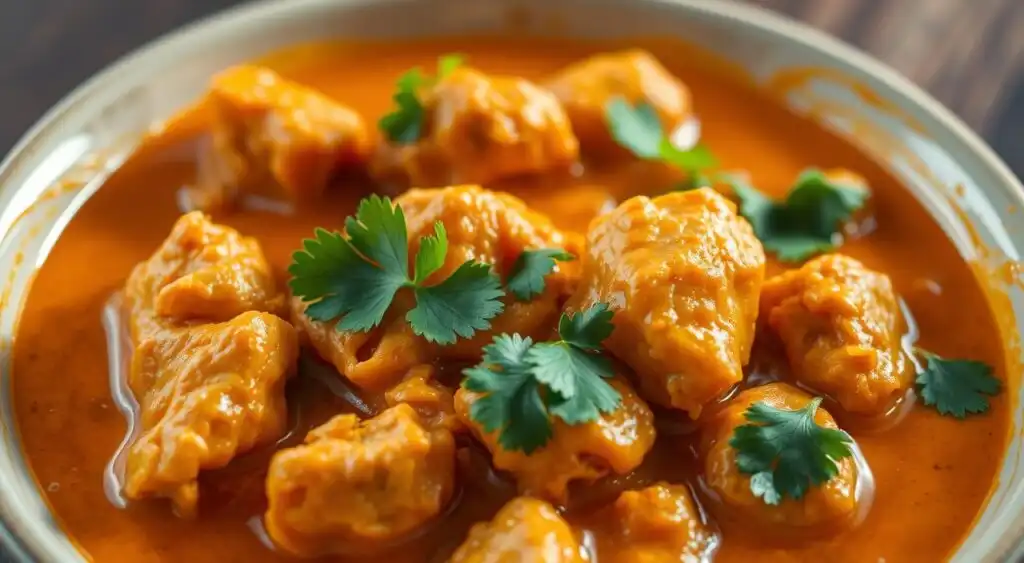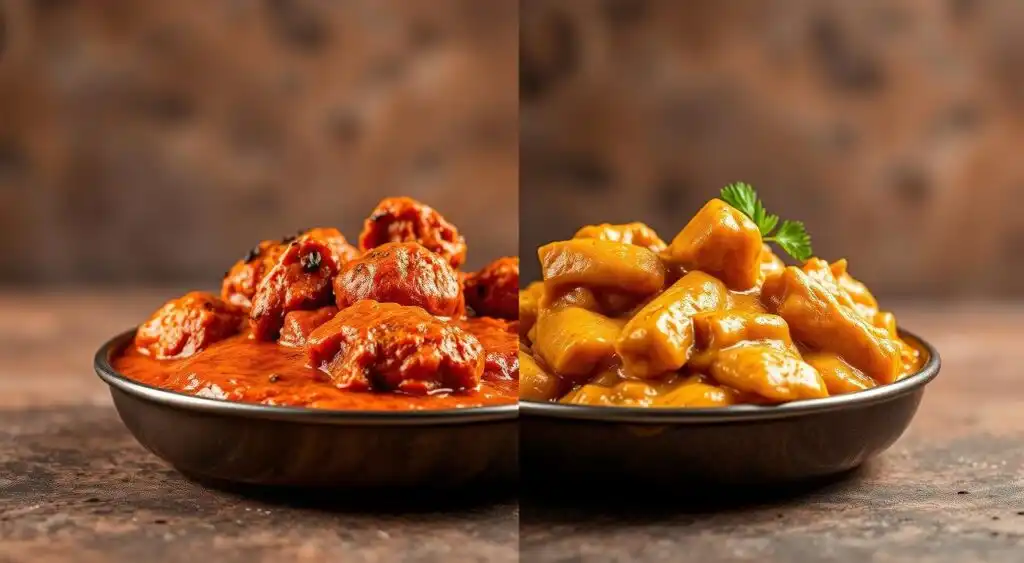Have you ever wondered if your favorite creamy, spiced dish is as indulgent as it tastes? Chicken tikka masala, a beloved staple of Indian cuisine, is known for its rich tomato sauce and bold flavors. But how does it stack up nutritionally?
This article dives deep into the nutritional profile of this popular meal. You’ll discover the calorie count, macronutrient breakdown, and how it fits into a balanced diet. Whether you’re curious about the protein, fat, or carb content, we’ve got you covered.
Using data from reputable sources like My Fit Foods and SnapCalorie, we’ll provide a comprehensive analysis. By the end, you’ll know exactly what’s in each serving and how it impacts your daily intake. Let’s uncover the facts behind this flavorful dish.
Table of Contents
Overview of Chicken Tikka Masala Nutrition
What makes this iconic dish a global favorite, and how does it fare nutritionally? This creamy, spiced creation has won hearts worldwide, but its nutritional profile is just as intriguing as its flavor. Let’s explore its origins, ingredients, and what makes it a balanced meal.
Origins, Ingredients, and Preparation
This dish traces its roots to Indian cuisine, blending marinated meat with a rich tomato-based sauce. The key ingredients include spices like cumin and coriander, which add depth to the flavor. Traditionally, the meat is grilled and then simmered in a creamy sauce, creating a harmonious blend of textures and tastes.
For those looking for a lighter option, yogurt or coconut milk can replace cream. This tweak not only reduces fat but also adds a tangy twist to the dish. Whether you stick to the classic recipe or opt for a healthier version, the result is always satisfying.
Macronutrient Breakdown and Value
One serving of this dish provides a balanced mix of macronutrients. It’s rich in protein, essential for muscle repair, and contains a moderate amount of carbs for energy. The fat content, primarily from the sauce, adds richness but can be adjusted based on your dietary needs.
Here’s a quick breakdown per serving:
- Protein: 24 grams
- Fat: 13 grams
- Carbohydrates: 18 grams
This combination makes it a filling meal that fits well into a balanced diet. Pair it with rice or naan for a complete dining experience.
chicken tikka masala calories: Detailed Nutritional Analysis
Understanding the nutritional details of your favorite dishes can help you make informed choices. Let’s dive into the specifics of this flavorful meal, focusing on its caloric content and macronutrient breakdown.
Caloric Content and Serving Size Insights
Understanding the caloric content and proper serving sizes is essential for mindful eating, whether you’re enjoying a classic dish or experimenting with creative recipes like chicken tikka masala cookies. The calorie count can vary significantly based on portion sizes and preparation techniques. For example, a 12 oz portion might contain roughly 540 calories, whereas a 250g serving comes in at around 300 calories. This discrepancy underscores the importance of precise portion control, especially when ingredients and methods are modified.

In recipes where measurements are provided in gra (grams), such as when developing fusion items like chicken tikka masala cookies, even slight differences in ingredient amounts can impact the overall calorie count. Preparation methods also play a pivotal role using yogurt in place of cream can lower the calorie density, which is beneficial whether you’re preparing a traditional chicken tikka masala or a creative twist on the dish in cookie form. Paying attention to these details helps in tailoring the dish to your dietary needs while still enjoying a flavorful experience.
An In-Depth Look at Fats, Carbs, and Protein
Chicken Tikka Masala is renowned for its rich, flavorful profile and nutrient balance, making it a satisfying and versatile meal. This dish provides a healthy mix of macronutrients, offering approximately 13 grams of fat, 18 grams of carbohydrates, and 24 grams of protein in a typical serving. The fat content is largely attributed to the creamy sauce that coats the chicken, providing a silky texture and depth of flavor. The chicken itself is the main source of protein in this dish, delivering essential amino acids that support muscle growth and repair.
Carbohydrates in Chicken Tikka Masala primarily come from the sauce base and any accompanying side dishes, like rice or naan. Adjusting these elements can allow you to personalize the meal according to your dietary preferences. For example, switching to whole-grain rice instead of white rice increases fiber content, which supports digestion and helps stabilize blood sugar levels.
In recent culinary experiments, the fusion of savory dishes with unexpected dessert twists has emerged, such as chicken tikka masala cookies. These cookies incorporate the rich flavors of the classic dish into a sweet, bite-sized form. By adjusting the amount of sugar and butter, one could craft a balanced cookie that includes the same fundamental macronutrients—fats, carbs, and protein. For instance, you could make these cookies with a slight increase in protein by adding chicken or protein powder while controlling the fat content by using a lighter alternative to cream.
Whether you are aiming for a protein-packed meal, a lighter dish with fewer fats, or a unique dessert like chicken tikka masala cookies, small changes to ingredients can make a significant impact on the nutritional profile.
Nutritional Comparison with Similar Indian Dishes
When comparing popular Indian dishes, the nutritional differences can be surprising. Two favorites, Chicken Tikka Masala and Butter Chicken, often get confused but have distinct profiles. Let’s break down their key differences and how they impact your meal choices.
Calorie and Ingredient Differences
Butter Chicken and Chicken Tikka Masala differ not only in their signature flavors but also in their nutritional profiles and ingredient bases. For example, Butter Chicken is renowned for its rich, creamy sauce, achieved by using heavy cream and butter. This combination boosts its calorie count—typically around 497 calories per serving with about 35 grams of fat—making it a delightfully indulgent option for those seeking comfort food.
In contrast, Chicken Tikka Masala uses a tomato-based sauce that is often enriched with yogurt or coconut milk instead of heavy cream. This substitution not only provides a tangy and vibrant flavor but also results in a slightly higher calorie count (approximately 540 calories per serving) while significantly reducing the fat content to around 19 grams. The lighter texture and lower fat content make Chicken Tikka Masala an attractive choice for those who are mindful of their fat intake.

Beyond the Traditional Dishes: A Fusion Twist
The distinctive ingredients in these dishes have even inspired creative culinary experiments. For instance, innovative chefs have begun exploring fusion recipes like chicken tikka masala cookies. These cookies incorporate the iconic spices and tangy notes of Chicken Tikka Masala into a sweet-savory treat. By experimenting with ingredients measured precisely in grams such as spices, yogurt, and coconut milk bakers aim to capture the essence of the traditional dish while offering an entirely new snacking experience.
This experimental approach not only broadens the scope of Indian fusion cuisine but also reflects how ingredients traditionally used in savory dishes can be reimagined in desserts. Whether enjoyed as a unique snack or a conversation-starting dessert at a party, chicken tikka masala cookies highlight the versatility of these ingredients and their ability to bridge culinary traditions.
In summary, while Butter Chicken’s richness is primarily due to its heavy cream and butter base, Chicken Tikka Masala offers a lighter alternative through the use of yogurt or coconut milk. The fusion twist of chicken tikka masala cookies further demonstrates the creative potential inherent in these classic recipes, inviting both traditionalists and adventurous eaters to explore new dimensions of flavor and texture.
Impact of Sauce Variations on Overall Nutrition
Sauce variations play a crucial role in determining the nutritional profile of many popular dishes. Whether you’re indulging in Butter Chicken or opting for Chicken Tikka Masala, the sauce is often what defines both the flavor and the nutritional impact of the meal.
For example, Butter Chicken features a rich, creamy sauce made with butter and cream, contributing to its higher fat and calorie content. While the sauce adds a luxurious taste, it significantly increases both the fat and calorie count, making this dish a heavier choice, especially when paired with a side like naan or rice.
In contrast, Chicken Tikka Masala typically uses a tomato-based sauce, which is spicier but less calorie-dense. This variation provides a lighter alternative while still delivering bold flavors. While it is slightly higher in carbohydrates, the reduced fat content makes it a preferable option for those looking to maintain a balanced diet.r recipes. This simple swap reduces fat while maintaining the dish’s rich flavor. Small changes can make a big difference in your overall nutrition.
Conclusion
Exploring the nutritional aspects of this iconic dish reveals its balance of flavor and health. A typical serving offers a mix of protein, carbs, and fats, making it a satisfying meal. Portion control and ingredient choices, like using yogurt instead of cream, can significantly impact its health.
When compared to similar dishes, the tomato-based sauce in this recipe stands out for its lighter profile. Understanding serving sizes and nutrient labels helps you make informed choices. Small tweaks, such as pairing it with whole-grain rice, can enhance its nutritional value.
By considering these factors, you can enjoy this flavorful dish while aligning it with your dietary goals. Whether you’re aiming for higher protein or lower fat, knowledge empowers you to savor every bite responsibly.
** Similar meals that may interest you:
How to Make Butternut Squash Soup
How to Make Taco Soup Fritos Recipe
1 thought on “Is Chicken Tikka Masala High in Calories? Full Nutritional Analysis”